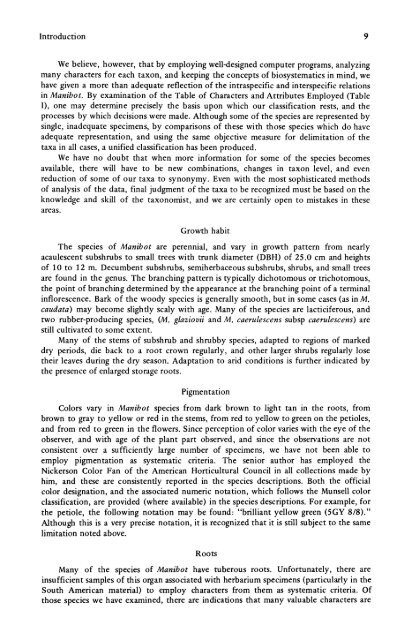Manihot Manihotoides (Euphorbiaceae) - CNCFlora
Manihot Manihotoides (Euphorbiaceae) - CNCFlora
Manihot Manihotoides (Euphorbiaceae) - CNCFlora
You also want an ePaper? Increase the reach of your titles
YUMPU automatically turns print PDFs into web optimized ePapers that Google loves.
Introduction 9<br />
We believe, however, that by employing well-designed computer programs, analyzing<br />
many characters for each taxon, and keeping the concepts of biosystematics in mind, we<br />
have given a more than adequate reflection of the intraspecific and interspecific relations<br />
in <strong>Manihot</strong>. By examination of the Table of Characters and Attributes Employed (Table<br />
I), one may determine precisely the basis upon which our classification rests, and the<br />
processes by which decisions were made. Although some of the species are represented by<br />
single, inadequate specimens, by comparisons of these with those species which do have<br />
adequate representation, and using the same objective measure for delimitation of the<br />
taxa in all cases, a unified classification has been produced.<br />
We have no doubt that when more information for some of the species becomes<br />
available, there will have to be new combinations, changes in taxon level, and even<br />
reduction of some of our taxa to synonymy. Even with the most sophisticated methods<br />
of analysis of the data, final judgment of the taxa to be recognized must be based on the<br />
knowledge and skill of the taxonomist, and we are certainly open to mistakes in these<br />
areas.<br />
Growth habit<br />
The species of <strong>Manihot</strong> are perennial, and vary in growth pattern from nearly<br />
acaulescent subshrubs to small trees with trunk diameter (DBH) of 25.0 cm and heights<br />
of 10 to 12 m. Decumbent subshrubs, semiherbaceous subshrubs, shrubs, and small trees<br />
are found in the genus. The branching pattern is typically dichotomous or trichotomous,<br />
the point of branching determined by the appearance at the branching point of a terminal<br />
inflorescence. Bark of the woody species is generally smooth, but in some cases (as in M.<br />
caudata) may become slightly scaly with age. Many of the species are lacticiferous, and<br />
two rubber-producing species, (M. glaziovii and M. caerulescens subsp caerulescens) are<br />
still cultivated to some extent.<br />
Many of the stems of subshrub and shrubby species, adapted to regions of marked<br />
dry periods, die back to a root crown regularly, and other larger shrubs regularly lose<br />
their leaves during the dry season. Adaptation to arid conditions is further indicated by<br />
the presence of enlarged storage roots.<br />
Pigmentation<br />
Colors vary in <strong>Manihot</strong> species from dark brown to light tan in the roots, from<br />
brown to gray to yellow or red in the stems, from red to yellow to green on the petioles,<br />
and from red to green in the flowers. Since perception of color varies with the eye of the<br />
observer, and with age of the plant part observed, and since the observations are not<br />
consistent over a sufficiently large number of specimens, we have not been able to<br />
employ pigmentation as systematic criteria. The senior author has employed the<br />
Nickerson Color Fan of the American Horticultural Council in all collections made by<br />
him, and these are consistently reported in the species descriptions. Both the official<br />
color designation, and the associated numeric notation, which follows the Munsell color<br />
classification, are provided (where available) in the species descriptions. For example, for<br />
the petiole, the following notation may be found: "brilliant yellow green (5GY 8/8)."<br />
Although this is a very precise notation, it is recognized that it is still subject to the same<br />
limitation noted above.<br />
Roots<br />
Many of the species of <strong>Manihot</strong> have tuberous roots. Unfortunately, there are<br />
insufficient samples of this organ associated with herbarium specimens (particularly in the<br />
South American material) to employ characters from them as systematic criteria. Of<br />
those species we have examined, there are indications that many valuable characters are

















